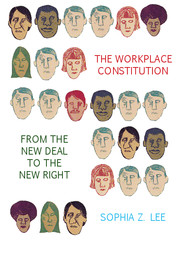
New book raises the question of when bureaucratic constitutional interpretation is desirable and sustainable.
In a narrative of great depth and nuance, Sophia Lee’s The Workplace Constitution tells how the National Labor Relations Board (NLRB) and the Federal Communications Commission (FCC) took upon themselves a duty, under the Fifth Amendment’s principle of equal protection, to prevent the companies (and, in the NLRB’s case, the unions) under their jurisdiction from discriminating among employees on the basis of race and, in some contexts, sex. But, as Lee makes clear, this strain of administrative constitutionalism did not become a permanent part of American law.
Although the Civil Rights Commission (CRC) in 1970 pressured every federal regulatory agency to follow the NLRB-FCC example and to recognize its supposed constitutional duty “to end any discriminatory practices (including employment) of … all who deal with the agency,” the initiative came to naught. The Federal Power Commission resisted the CRC’s call and largely won in the Supreme Court in 1976, after which regulatory agencies generally decided that “very little” was required of them in the way of preventing workplace bias. The FCC’s policy on equal employment would be struck down altogether in the 1990s, while the NLRB’s policy, though technically still alive, is now “tucked away in an obscure agency manual and rarely put to use.”
Lee unearths and analyzes a wealth of important material on what can happen when an agency seeks to enforce the constitution. I would like to reflect here on what her material suggests about whether (or when) bureaucratic enforcement of the constitution is normatively desirable and practically sustainable.
There are many normative arguments for administrative power generally, but perhaps the most foundational – and the only one I shall discuss here — is that an agency is suited to acquire the specialized capacity to effectively convert the value choices of some higher authority (such as the legislature) into reality – capacity that is rooted in the knowledge and commitment of the agency’s personnel. Personally, I think it’s a fine idea for agencies to play a role in implementing not only the value choices that come from the legislature but also those that come from the constitution (i.e., from the complicated mix of institutions and popular feelings that produce constitutional choice, including the Supreme Court). Indeed, many have argued that the aspiration of Brown v. Board was made a reality thanks to Congress’s enactment of the Civil Rights Act, the Voting Rights Act, and the Elementary and Secondary Education Act – and also, crucially, by the aggressive enforcement of those statutes by the Department of Justice and the Department of Health, Education, and Welfare (especially the agencies’ use of statistics to define, measure, and demand school districts’ progress in integration).
That being said, the policy-implementing capacities that an agency can effectively maintain and use are not infinite. An agency that is good at one thing may, for that very reason, be bad at doing anything else. Given this, one must take seriously Chief Justice Burger’s warning in a 1976 concurrence that diffusing responsibility for fighting employment discrimination among numerous regulatory agencies, each primarily concerned with some other subject, was a bad idea. One is reminded of the cogent arguments made by environmentalists, circa 1970, that (a) environmental values would never receive sufficient attention from industry-specific and industry-focused agencies like the Interstate Commerce Commission, the Federal Power Commission (FPC), or the Atomic Energy Commission, and (b) an agency specifically devoted to environmental protection – an Environmental Protection Agency – was therefore necessary.
 But the industrial-regulatory agencies in Lee’s story were not all equally incompetent to enforce workplace equality. In fact, they differed widely in their claims to specialized capacity for this task. At one extreme was the FPC, with a focus on the relation of a regulated utility to its customers, not its employees. The FPC recoiled from any mandate to handle employment discrimination, based on a narrow view of its mission that was largely endorsed by the Supreme Court.
But the industrial-regulatory agencies in Lee’s story were not all equally incompetent to enforce workplace equality. In fact, they differed widely in their claims to specialized capacity for this task. At one extreme was the FPC, with a focus on the relation of a regulated utility to its customers, not its employees. The FPC recoiled from any mandate to handle employment discrimination, based on a narrow view of its mission that was largely endorsed by the Supreme Court.
At the other extreme was the NLRB, with a competence precisely in the realm of employment (and perhaps even more relevant, after the Landrum-Griffin Act of 1959, in the realm of internal union governance). The NLRB’s special competence seemed evident from the complexity of the issues involved in the fateful Hughes Tool proceeding of 1962-64: whether the Fifth Amendment made it an unfair labor practice for a white local and employer to negotiate and approve discriminatory contracts and for the white local to fail to grieve a black worker’s exclusion from an apprenticeship program. Even the Justice Department’s Civil Rights Division was, as Lee recounts, initially skittish to become involved in Hughes Tool, for the matter was, according to a Division report, “extremely complex,” and the Division was “completely inexperienced in this area.” Between the two extremes was the FCC: this agency was not designed to focus on employment, but as Lee reminds us the Supreme Court said, it had a “statutory duty to ensure that broadcasting ‘reflect[ed] the tastes and viewpoints of minority groups,’” to which minority employment was relevant.
It is an especially intriguing question, then, why the NLRB, despite its plausible claims to expertise in employment and union governance, did not play a lasting role in the interpretation and enforcement of workplace equality grounded in constitutional equal protection. To be sure, the Supreme Court’s state action jurisprudence went in an unfriendly direction. But the Court’s 1970s case law did not entirely foreclose a constitutionally-inflected reading of the National Labor Relations Act. And in any event, it is possible for an agency – if it builds a strong enough reputation for unique competence – to win deference from the courts. (Consider, for example, the Food and Drug Administration as portrayed in Daniel Carpenter’s Reputation and Power.)
The problem for the NLRB, as Lee’s beautifully researched and subtle narrative suggests, was that the Fifth Amendment proved so indeterminate in its policy meaning. As fleshed out by Nixon appointees, the Board’s equal protection policies became susceptible to manipulation by employers resisting collective bargaining. This, in turn, caused subsequent Board members in Handy Andy to abandon the practice of decertifying discriminatory unions or releasing employers from the obligation to bargain with such unions, as such actions undermined collective bargaining and perversely aided recalcitrant employers.
The one Board member to reject the agency’s turnabout was Howard Jenkins, who had written the Hughes Tool decision establishing the Board’s constitutionalism back in 1964. Jenkins in 1977 maintained faith that the Board’s equal employment policies could be used for liberal purposes, yet in answering the Handy Andy majority, he was thrown back on an anti-policy formalism: “The constitutional impediment to certification of a discriminating union … forecloses consideration of policy reasons for adopting a procedure which … postpones determination of disqualifying discrimination to a later date.” With such language, Jenkins gave up one of the strongest grounds for a distinctly administrative constitutionalism: the notion that agencies can bring constitutional aspirations nearer to reality precisely through policy thinking about the efficacy of government action.
It is often said that agencies have the hardest time building up authority and legitimating themselves when their goals are ambiguous and contested. This was true of federal policy regarding unions, whether rooted in the NLRB’s statutes or, as Lee vividly shows, in the Fifth Amendment. It seems from Lee’s narrative that certain organizational features of the Board aggravated goal definition problems. One was its “independent” status, which precluded the possibility of presidential direction and protection and left unclear “[e]xactly whom the Board members were supposed to be independent from and to whom (or what) they owed a duty.” Another was the Board’s multi-member, multi-partisan structure, which produced the fractured policymaking of the Nixon era, including the Board’s inability to achieve the consensus necessary for rulemaking – one of the most effective bureaucratic technologies of the post-1970 era. Perhaps such factors help explain why the NLRB – despite much experience and expertise relevant to workplace equality – never succeeded in establishing a distinctly administrative legitimacy in the enforcement of constitutional rights.
This essay is part of a six-part series, The Struggle Over the Constitution in the Workplace.




